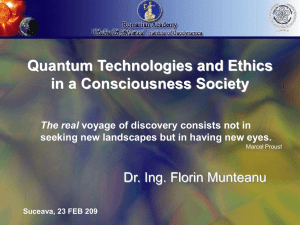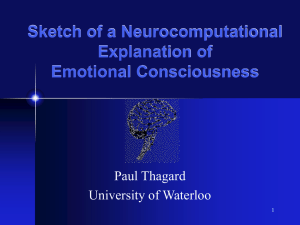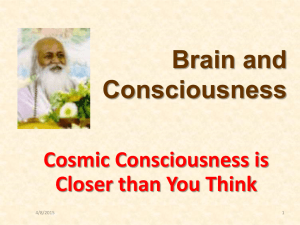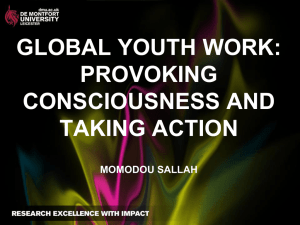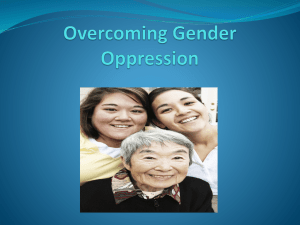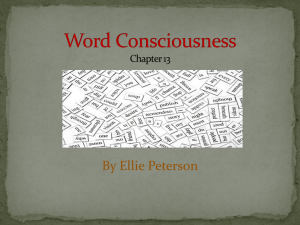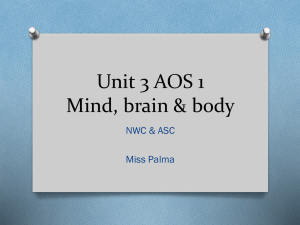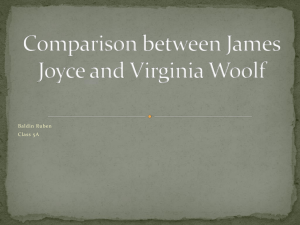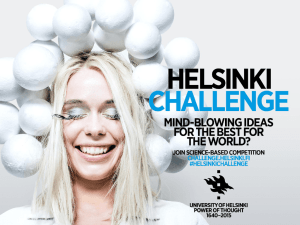Damasio`s Keyterms
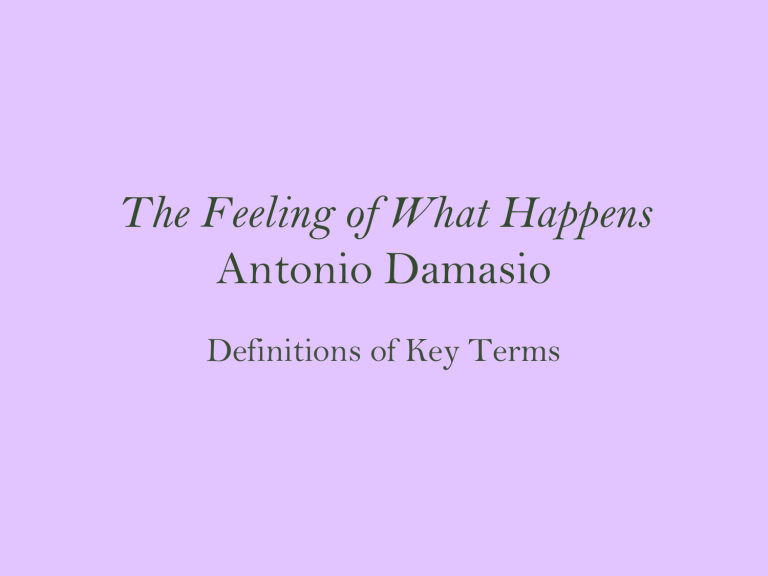
The Feeling of What Happens
Antonio Damasio
Definitions of Key Terms
Organism
–
Object
–
Image
The organism in question is that within which consciousness occurs; the object in question is any object that gets to be known in the consciousness process; and the relationships between organism and object are the contents of the knowledge we call consciousness. Seen in this perspective, consciousness consists of constructing knowledge about two facts: that the organism is involved in relating to some object, and that the object in the relations causes a change in the organism .
(20)
Antonio R. Damasio, The Feeling of What Happens
I regard the problem of consciousness as a combination of two intimately related problems. The first is the problem of understanding how the brain inside the human organism engenders the mental patterns we call, for lack of a better term, the images of an object . By object I mean entities as diverse as a person, a place, a melody, a toothache, a state of bliss; by image I mean a mental pattern in any of the sensory modalities, e.g., a sound image, a tactile image of an object, the image of a state of wellbeing. Such images convey aspects of the physical characteristics of the object and they may also convey the reaction of like or dislike one may have for an object, the plans one may formulate for it, or the web of relationships of that object among other objects.
Quite candidly, this first problem of consciousness is the problem of how we get a
“ movie-in-the-brain,
” provided we realize that in this rough metaphor the movie has as many sensory tracks as our nervous system has sensory portals—sight, sound, taste, and olfaction, touch, inner senses, and so on. (8)
. . . solving the second problem of consciousness consists in discovering the biological underpinnings for the curious ability we humans have of constructing, not just the mental patterns of an object—the images of persons, places, melodies, and of their relationships, in short, the temporally and spatially integrated mental images of something-to-be-known—but also the mental patterns which convey, automatically and naturally, the sense of self in the act of knowing. Consciousness, as we commonly think of it, from its basic levels to its most complex, is the unified mental pattern that brings together the object and the self.
In the very least, then, the neurobiology of consciousness faces two problems: the problem of who the movie-in-the-brain is generated, and the problem of who the brain also generates the sense that there is an owner and observer for that movie. The two problems are so intimately that the latter is nested within the former. In effect, the second problem is that the appearance of an owner and observer for the movie within the movie; and the physiological mechanisms behind the second problem have an influence on the mechanisms behind the second problem have an influence on the mechanisms behind the first. In spite of the intimacy of the problems, however, separating them is a way of breaking the problem of consciousness into parts and, in so doing, making the overall investigation of consciousness manageable. (11)
Core consciousness - Enables a sense of self about one moment
— now
— and one place
— here. The scope of core consciousness is here and now. Core consciousness does not illuminate the future, and the only past it vaguely lets us glimpse is that which occurred in the instant just before. Core consciousness arises through the interaction of organism and object; the brain of the organism creates an image of its internal state, an image of the object, and an image of the internal state as it is “ modified ” by its interaction with the object. In addition, it creates a “ second-order ” image that includes all of these and may result in the “ feeling ” of the self experiencing the resulting qualia.
See p. 16 and pp. 82
–
106 and 168
–
194.
Extended consciousness - Enables an elaborate sense of self — an identity and a person, you or me, now less — and places that person at a point in individual historical time, richly aware of the lived past and of the anticipated future, and keenly cognizant of the world beside it. There are many levels and grades of extended consciousness, which requires core consciousness and working memory in order to form a sense of self in the act of knowing. It is expanded and enriched by language and long-term memory. See p.
16 and pp. 195 – 233, particularly 222 (at the top).
Qualia - The simple sensory qualities to be found in the blueness of the sky or the tone of sound produced by a cello, and the fundamental components of the images in the movie metaphor are thus made of qualia. See p. 9.
Emotions - Outwardly directed and public; complex collections of chemical and neural responses; biologically determined; six primary emotions (happiness, sadness, fear, anger, surprise, disgust) and many secondary or social emotions (including embarrassment, jealousy, guilt, or pride) and background emotions (including wellbeing, malaise, anxiety, calm, tension). See p. 42.
Feelings - Inwardly directed and private awareness of qualia, experience, emotion, etc.; feelings allow qualia and emotions to impact the mind. Feelings can be nonconsciousness, but when we become aware of them, that ’ s consciousness. “ Background feelings, ” arising from background emotions, include fatigue, energy, excitement, wellness, sickness, tension, relaxation, surging, dragging, stability, instability, balance, imbalance, haromony, and discord (286). See pp. 30
–
31.
Image - Any mental pattern; an image may be conscious or nonconscious. The familiar image is visual, but the brain and mind form images related to all the senses, emotions, cognition, and the internal milieu of the body. See p. 9.
Neural pattern - The physiological correlate of an image. See pp. 317 – 18.
Representation - Can mean mental image, mental pattern, or neural pattern. A work of art represents its subject in paint or words. The brain represents its subject in a neural pattern, which results in a mental image or mental pattern. See p. 320.
Proto-self “ A coherent collection of neural patterns which map, moment by moment, the state of the physical structure of the organism in its many dimensions ” (154). The proto-self is crucial to Damasio ’ s theories, because it is both the evolutionary precursor to and foundation for core consciousness. See pp. 155
–
56 for a discussion of the brain structures Damasio hypothesizes are involved with “ implementing ” the proto-self.
Autobiographical self - The autobiographical self is made possible by extended consciousness and is
“ based on autobiographical memory which is constituted by implicit memories of multiple instances of individual experience of the past and of the anticipated future
”
(174). Our brains, when functioning normally, process the images of core consciousness along in coordination with the implicit
“ autobiographical
” memory.
This is one reason that core and extended consciousness, while separate mechanisms according to Damasio
’ s theory, are so intimately linked.
Wordless storytelling - According to Damasio “ the imagetic representation of sequences of brain events, which occurs in brains simpler than ours, is the stuff of which stories are made ” (188). He suggests that the
“ story
” created through the interaction of organism and object is crucial for core consciousness and may be the original source for all narrative. In his view, the most basic form of consciousness may be a sort of blueprint for the making of narrative. Another implication is that narrative (and by extension literature) may be fundamental to thought itself. Other thinkers have suggested something similar, including Mark Turner and Gilles Fauconnier. See also pp. 184
–
85.
Body loop - The central nervous system ’ s mapping of changes in body state, created through chemical signals via the bloodstream and neural signals via nerve pathways (79-80)
As if body loop - A representation of changes in body state created in the nervous system and brain. In
Damasio ’ s words, “ It is ‘ as if ’ the body has changed but it has not ” (80). See also p. 281.
PET (positron emission tomography) a radioactive isotope is injected into “ tissues of interest, ” which can then be scanned and rendered in 3-D. See http://www.radiologyinfo.org/en/info.cfm?PG=pet . fMRI (Functional Magnetic Imaging) measures the magnetic resonance of blood flow (an indirect measure of neural activity). See http://www.fmri.columbia.edu/fmri.htm .
EEG (electronencephalography)
– measures electrical activity in the brain, though electrodes on the scalp. See http://www.pbs.org/wnet/brain/scanning/eeg.html
.
